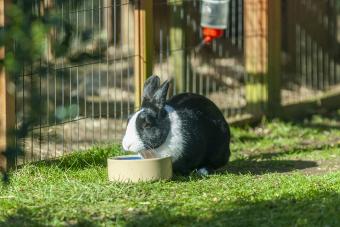
How to clean a rabbit cage is an essential skill for pet parents. Healthy bunnies need a clean and dry indoor and outdoor hutch, even if it is freezing. This is a rule of thumb and not a task you can ignore without serious consequence.
How to Clean a Rabbit Cage in Six Easy Steps
A clean and dry rabbit cage is a priority for rabbit lovers and one of the most important tasks to keep your bunny happy and healthy. When you remove the bunnies to clean, look them over and make sure the gang is healthy.
Rabbit Cage Cleaning Supplies
Large, round fecal pellets are normal. The majority of the weekly cleaning consists of removing poop from the cage. This cleaning session is the perfect opportunity to ensure you do not see any diarrhea or abnormal fecal movements. Before you head out the door, make sure all the cleaning gear is in a wheelbarrow. If you are cleaning an indoor hutch, pull together all the items before you head over to the cage.
- Temporary cage or housing for rabbits
- Two buckets for old bedding and soapy water
- Garbage bag
- Manure scraper
- Gloves
- Two brushes and a natural dish soap
- Natural paper bedding
- Freshwater for waterers

Step One: Remove Everything in the Hutch
After you move the waterer, food dishes, nest boxes, and bunnies to a temporary cage, you may begin cleaning the cage. The temporary hutch is also a great opportunity to give your bunny a chance to play and to dig.
Step Two: Remove Old Bedding
Put on your gloves and grab the first bucket. Remove all the bedding and scoop out the fecal droppings. If the cage is large, an empty garbage bag is also an excellent solution for soiled bedding.
Step Three: Scrub the Drop Tray
There may be a cleanout panel for droppings as many hobbyists place trays in the area of the cage where the rabbits potty so cleaning is easier and more efficient. Remove this and scrub the tray with a brush and dish soap. Place outdoors or in a garage to dry.
Step Four: Scrub the Cage and Flooring
If you own a wire cage, it may be easier to remove each panel before cleaning. Scrub each panel with a brush and dish soap and put the metal cage back together to dry either outdoors or in a garage. Never use any chemicals. If the hutch or cage is outdoors or in a shed with a solid floor and not a wire cage, scrub those walls and corners!
Step Five: Clean the Accessories and Add New Bedding
Remove the accessories from the temporary cage and clean the waterer first! Scrub the dishes with dish soap and look over the nesting boxes. Grab the dry wire cage and add new bedding and straw or natural paper bedding. If your bunnies live in a hutch with a solid floor, make sure it is dry before the bedding is replaced.
Step Six: Return the Bunnies and Accessories
Refill the waterer with fresh water, food dish with hay or pellets, and add back in any accessories drying outdoors. How does it smell? If you are satisfied with the new bunny environment, it is time for your rabbits to return to the cage or hutch. Wash your hands!

How Often to Clean a Rabbit Cage or Hutch
If you are a pet parent with a rabbit hutch, outdoor rabbitry, a wire cage, or a hutch in a wooden shed with a solid floor, the enclosure needs a weekly cleaning session. Daily maintenance is also important, and this consists of feeding your bunnies and replacing the waterers. With that in mind, cleaning the entire cage or hutch once a week needs to part of the family's schedule.
Daily Maintenance
The waterer needs fresh water each day and pet parents need to spot check the pellet and hay supply. Always remove any food you find on the bedding or on the floor of the hutch or cage. Pet parents may clean the litter box or the drop tray with a cat litter box scooper and a bucket if there are many fecal pellets.
Plan to Clean Your Rabbit Hutch Weekly
Weekly deep cleanings are one of the most important tasks to ensure your rabbits stay happy and healthy. If you stay on top of the weekly sessions, the entire cleaning exercise may only take an hour at the most. Animal lovers never want small pets to sit in poop all day. A clean and dry hutch is the goal, and between daily maintenance and weekly deep cleaning sessions your rabbits may live a long healthy life.







